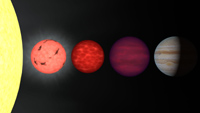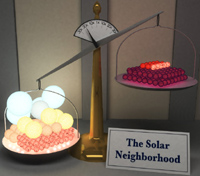|
 |

 |

| An artist's rendition comparing
stars, brown dwarfs, and planets to the same size
scale. From left to right is the limb of the Sun, a
very low mass star (red dwarf), a pair of brown dwarfs, and the planet
Jupiter. These objects have masses ranging from 1000 times that of Jupiter
(for the Sun) through 75, 65, 30, and 1 Jupiter mass,
respectively. Despite the range in mass, all four of the low-mass
objects are approximately the same size, ten times smaller than the diameter
of the Sun |
|
Until recently the distinction between stars and planets was clear, but in the last few years astronomers have discovered a wealth of objects with masses between those of stars and planets. Such objects are called brown dwarfs.
Brown dwarfs share characteristics with both stars and planets. They are thought
to form the same way that stars do—from collapsing gas that heats up
within interstellar clouds—but with too little mass to generate the heat
sufficient to ignite hydrogen fusion in
their cores. The coolest known brown dwarfs have complex atmospheres composed
of molecules such as methane, a trait also seen in the giant planets of our
Solar System. As a result, brown dwarfs are useful tools in teaching us not
only about the low-mass end of star formation but also about the chemical makeup
of exoplanets.
These brown dwarfs, because they have no central energy source, continue to cool forever, much like embers plucked from a roaring fire. Also like embers, brown dwarfs become redder as they cool, so the best prospect for discovering them is with surveys conducted at infrared wavelengths. Current surveys such as the Two-Micron All Sky Survey (2MASS) and the Sloan Digital Sky Survey (SDSS) have been instrumental in discovering hordes of these objects.

| A sample
of stars within 26 ly of the Sun and
visible from the northern hemisphere. Stars
are on the left and an estimate of the number of
brown dwarfs on the right. There are
4 blue stars, 1 green-tinted star, 5 yellow stars
(including the Sun), 22 orange stars,
87 red stars, and 9 white dwarfs. The brown
dwarfs are composed of a few red and
redder dwarfs along with lots of magenta dwarfs
(or cooler objects).
Despite the fact that there are at least as many brown
dwarfs as stars, the stars are responsible for most
of the mass. |
|
 |
 |
Despite the success of surveys such as 2MASS and SDSS, they have been unable to find brown dwarfs cooler than 750 degrees Kelvin. Cooler objects primarily emit light at wavelengths longer than either of those surveys probe, and it is at these wavelengths where WISE will operate. With WISE we will be able to see 450-K brown dwarfs out to a distance of 75 light-years (ly), 300-K brown dwarfs out to 20 ly, and 150-K brown dwarfs out to 10 ly. Finding these cooler objects will provide examples of exoplanet-like atmospheres in order to investigate atmospheric properties in the unexplored temperatures between 150 and 750 Kelvin.
WISE will determine how common these objects are in our own Solar Neighborhood, allowing us to measure the efficiency of the star formation process at its lowest masses. WISE will also allow us to determine if star formation has a cut-off mass below which formation is inhibited. At the moment, we believe that brown dwarfs are as prevalent as stars. Because brown dwarfs are so common, it is likely that the closest "star" to the Sun is not Proxima Centauri but some hitherto undiscovered brown dwarf that will be imaged successfully for the first time by WISE.
|
 |





